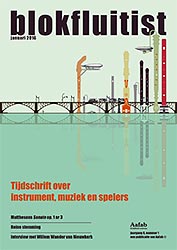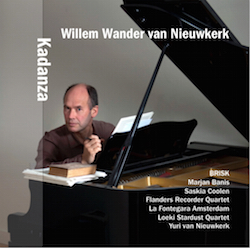This interview previously appeared in The Recorder, volume 8, no. 1 (January 2016)

by Stephanie Brandt
Willem Wander van Nieuwkerk is known, among other things, for his versatile and accessible compositions that are often inspired by pop or jazz music. He recently released the CD Kadanza with his collected music for recorder, written between 1985 and 2015. ‘Recorder’ spoke to the composer about his sources of inspiration, the development of the recorder and the role of the (amateur) performer in contemporary music.
Briefly introduce yourself to our readers; what should they know about you?
I am a composer and have studied musicology, I play the piano but have also performed as a percussionist and conductor. In addition, I am an amateur chorister. Beauty, friendship and my family are important to me. When I have a musical idea, writing on note paper or improvising at the piano, I feel happy. Well, I mostly do.
I have developed somewhat ‘backwards’. I improvised first and then learned to play the piano properly. I learned new music first and then old. I listened to all kinds of non-classical music and only then got to know the traditional ‘classical music’ that I am part of now. I often find many ‘normal’ things extremely abnormal and new.
Recently, the CD Kadanza was released. Why this title, and what kind of music can we expect on this CD?

The title track, Kadanza, was created as the upbeat finale of a dance performance for children. My wife was a dancer: she gave me the rhythmic outline of the dance, which I realised on a Yamaha DX7 synthesiser, using a shakuhachi sample as the sound. Later, someone came up with the bright idea of using real flutes for it. That practical genesis is typical of much of the music on the CD. Dance rhythm is also almost always heard. So, I thought it was a very appropriate title. The genres are quite diverse. There is music on it inspired by bebop, Gregorian chant, Burundi war drumming, klezmer, tango and blues, Beethoven, medieval dance music, the caccia of the trecento and salsa.
The recorder seems to recur throughout your oeuvre. What fascinates you about this instrument? And what is your favourite recorder?
The recorder is the paperclip among instruments: it seems so simple, but just try to figure it out. That deceptively ‘simple’ sound has a directly compelling beauty that seems not quite of this world. ‘Pure’ is a nice word for it. Especially notable, of course, is the pedagogical mission that has traditionally clung to the instrument. When you start learning to play it, everything is deceptively simple, but then that little wooden pipe turns out to contain virtually all the wonders of music, including the most virtuoso music. To be best known as a beginner’s instrument is sometimes considered detrimental, but I would be proud of it. The recorder is the true pedagogue among instruments.
The recorders I like best are Renaissance recorders, perhaps because they seem slightly more vocal than later models. But the instruments are generally not that important, the musicians who play them all the more.
What role does collaboration with recorder players play?
Collaboration between composer and player is the most important thing, from the idea of the piece through its creation to finishing the score and, finally, the performance. Every instrument and instrumentation has peculiarities: the player introduces you to them and gives you ideas. As a composer, you run up against ‘limitations’ but also discover unsuspected possibilities that often belong to the instrument’s peculiarities. I am a pianist myself, with a background in improvisation and jazz. As a composer, I started working first and foremost with pop musicians and specialists in avant-garde techniques. I already knew a bit about the recorder’s repertoire and history, but my meeting with Saskia Coolen and the members of the then La Fontegara Amsterdam was crucial. They taught me about the instrument and instrumentation, and Saskia, in particular, still does. But the same applies to Brisk and, more recently, the Flanders Recorder Quartet. Every player working with composers has a part to play in this.
What makes composing for the recorder special?
I find the recorder family’s historical aura particularly inspiring. It is a huge halo of beautiful repertoire, from the vocal polyphony and dance music of the Renaissance to the breakneck virtuosity and lyricism thereafter, but also of wonderful functions, such as that of a consort instrument or choral voice versus that of the soloist or dancer who varies leaps. A gradus ad parnassum it offers, for the player and also, as an example of craft and artifice, for the composer.
Typically, the recorder repertoire from the end of the eighteenth century lacks about a century and a half of classical and romantic music. This is precisely the music that greatly interests me because of its dramatic power. I am now trying to do what the classical and romantic composers also did: draw freely from historical, light, and traditional folk music and pour them into untraditional but always ‘classical’ tightly shaped works. Then, along a diversion in the 21st century, the 19th century reached the recorder after all.
(How) has the recorder changed in the 30 years the CD covers?
For a long time, there was a tendency among players to show: ‘We recorder players can compete too’, a feeling of having to catch up. I have always found that unfortunate, especially when it led to needlessly complicated fuss and excessive toughness. The fact is that ‘modern music’ came late to the recorder, but that backlog has long since been cleared. Thankfully, then, no more frustrations. In that development, people liked to profile themselves as extreme forerunners by using new media. I always find that interesting, be it in the field of the recorder, the violin, or the triangle. In the late 1980s, I did a project with Saskia Coolens Foundation Recorders, about live sampling, sequencing and the repetitive sound patterns you then get and how they can work spatially. Back then, though, that involved huge and expensive spool recorders and mixing consoles. Nowadays, anyone can have a small loop station.
Electronics, visual media, and the theatre that goes with them must be tried, if only because they take you to different concert platforms and audiences. The best thing about this development is that it brought pop music closer. And that brings me to the present: I think people now more freely arrange their own (own) pop music and folk music and freely use historical inspirations when making programmes, and all the novelties of the last decades have a logical place in them.
Are your compositions written more for amateurs or professionals?
I consider it a great honour when my piece is played by the best professionals, as on this CD, but I am equally highly honoured when amateurs play it at home or music school. Professional music practice relies entirely on that of amateurs, I am convinced. You can see that, for example, in all the bands and DJs in pop music. In the early days, professionals and amateurs sometimes worked side by side in classical orchestras. And what would sport be without amateurs? It is precisely the connection between amateurs and the professional circuit that keeps any discipline alive.
Do you have any tips for players who want to rehearse any of your works?
It certainly helps if you listen to this CD – that was one of the reasons for making it – but I am against imitation and in favour of inspiring one’s own conception. As a composer, I have very often learned something new and unexpected about my own pieces, precisely from the players. Dare to think for yourself and make the composer think about his own piece, for instance that phrasing could perhaps be viewed very differently or tensions constructed differently. Kadanza, for instance, was arranged by Trio Axolot in a kind of amplified ‘rock’ version. That suits the piece just right, although I wouldn’t have thought of it myself. Tempo choices can also vary enormously.
Ultimately, the audience, or my favourite audience, does not come to hear an instrument or a technique but to hear a musician tell a story. The best musicians I worked with handled my pieces most freely, in the sense of understanding and intelligence, both inside and outside the recorder world!
Thank you very much for this interview!